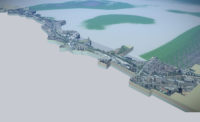 |
| First Steps. Submarine cable powers Admiralty Island. |
Isolated communities in southeast Alaska’s rugged, fjord-punctuated panhandle have moved a step closer to being plugged into a regional electricity grid with the completion of the first of eight electricity transmission projects last month. But costly missing links may still take years to complete.
Moving at a glacial pace, the $341-million program was first envisioned 20 years ago and is scheduled to be completed after 2030. About 20 communities will be connected over the next 20 to 30 years, under plans prepared in 2003 by D. Hittle & Associates Inc., Kennewick, Wash., for The Southeast Conference, Juneau, the region’s economic development association.
City Electric Inc., Anchorage, in early May completed the $20-million first project, a 69-kV AC link from Juneau to Admiralty Island, about 18 miles to the south. Work began in 2004, when $14.7 million of federal funds was earmarked for the submarine cable. Alaska Electric Light & Power Co., Juneau, which engineered the line, contributed $3 million. The rest came from Kennecott Greens Creek Mining Co., Admiralty Island, which will meet 25% of its electric needs with the cheaper hydroelectric power produced in the region.
Chichagoff Island and Hoonah, two small communities running on diesel generators, would be at the other end of the next link. They now are less than 30 miles from cheap hydropower, but closing that distance will cost an estimated $28 million.
The Anchorage-based Denali Commission, a federal-state partnership that provides critical utilities, infrastructure and economic support throughout Alaska, may fund the link. But co-chairman George Cannelos says interties can be big-ticket items and the Admiralty-Hoonah phase is not in the 2006 budget.
A 1987 study by Harza Engineering Co. (now MWH), Chicago, for the Alaska Energy Authority concluded, “a transmission system interconnecting many of the southeast Alaska communities is technically and economically feasible.” And the state’s 2007 capital budget, expected to be approved by Gov. Frank H. Murkowski (R), has $3 million toward development of an intertie between southeast Alaska and Canada.
Sources say Murkowski believes the intertie can boost regional economic development. British Columbia has put $500,000 toward research on an intertie system, says Thom A. Fischer, president of hydroelectric developer Tollhouse Energy Co., Bellingham, Wash.
(Photo courtesy of AEP&L)



Post a comment to this article
Report Abusive Comment